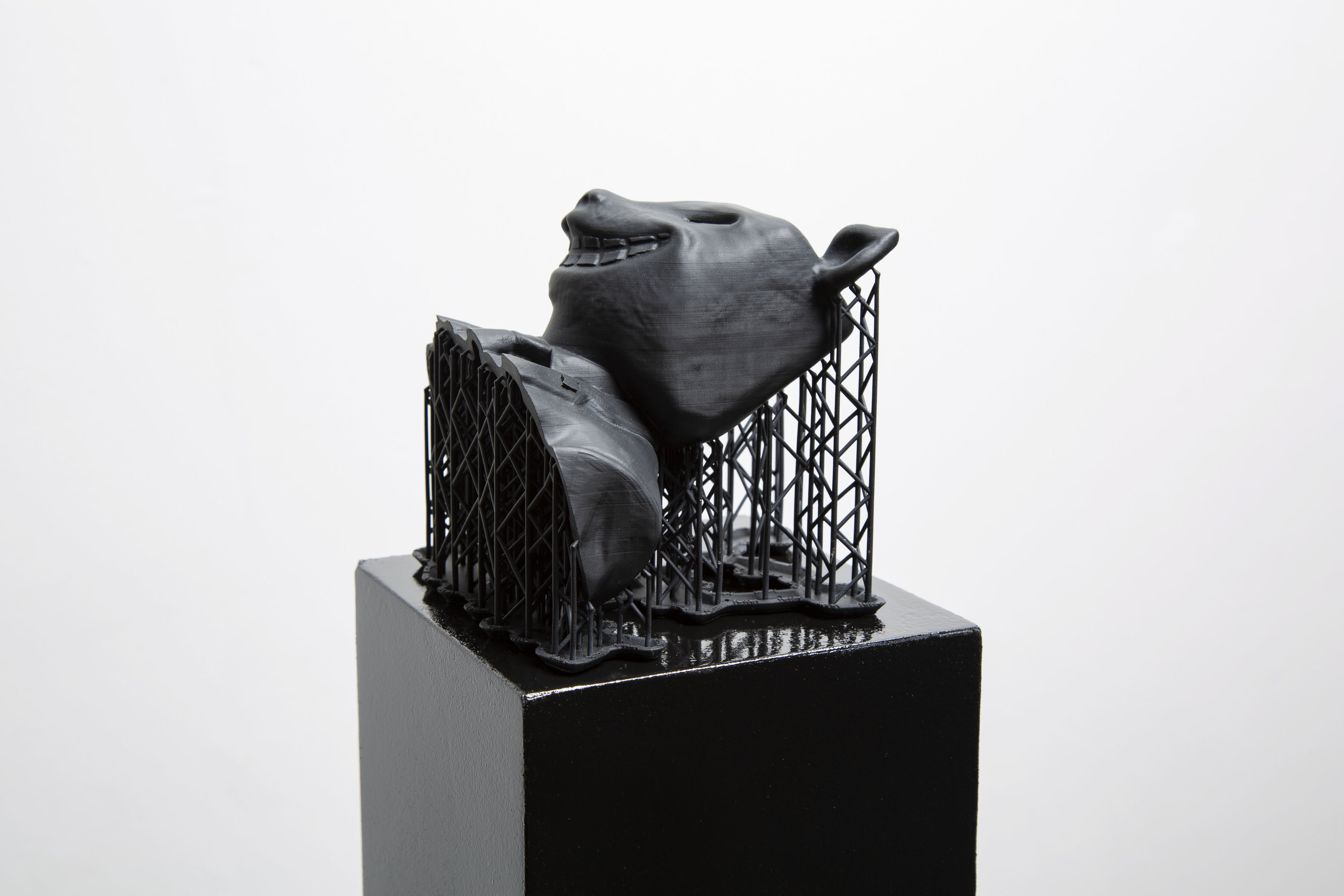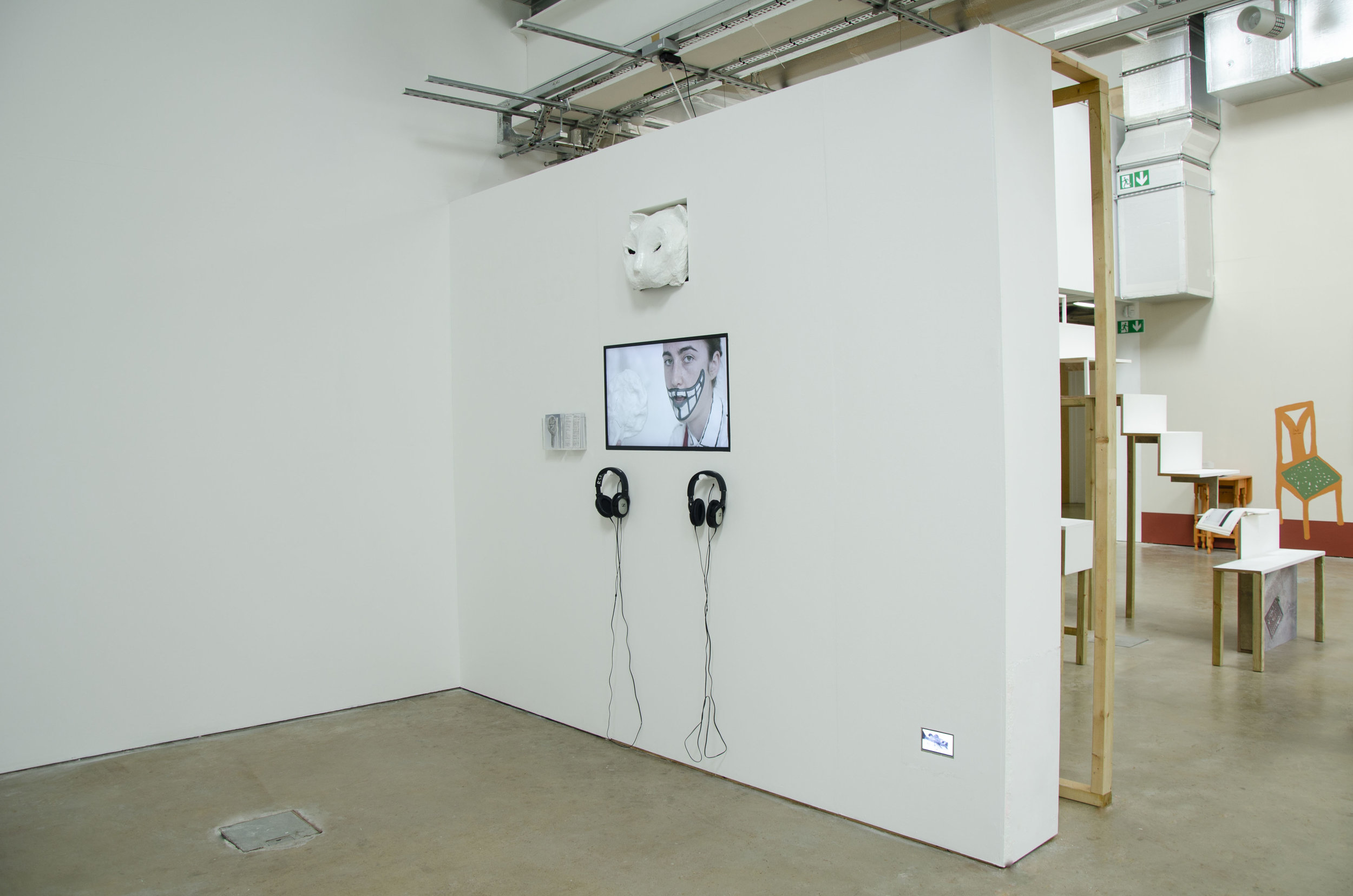Jessie Palmer

“When we think of a powerful person reduced to the image of a fat animal, we are far more inclined to let ourselves joke about them.”
Interview by: Natalia Gonzalez Martin
Could you tell us a bit more about yourself and your background? Where did you study?
I am a recent graduate of Ruskin School of Art, at the University of Oxford. Until my foundation, I had a very traditional art background in painting and drawing. I had a portrait artist for a grandmother and a sculptor for an uncle. Being in their studios was what got me hooked on making myself, but it was another relative’s collection of works by Paula Rego, that gave me a taste for the weird and the more unconventional that has really fed into my work.
My recent move to film has become a flattening process. It satisfies me the way the camera picks up on these rough and slightly unfinished aspects of my costumes and sculptures, allowing me to direct the viewer’s perspective. I like this element of control in particular, as I’ve really struggled with the medium of performance art, often finding my performances loose their momentum. However, even though I’ve found film, I am determined to go on to to research the latter further, looking at the 1960’s and the use of the ‘performance’ in a History of Art Masters this coming year.
For centuries cats have been idolised as seen as deities, their meaning has changed a lot through time, what do they represent for you?
I definitely haven’t been able to avoid this previous history and symbolism of Cats when discussing the “Fat Cat” in my practice, and I welcome a viewer that may bring this lexicon to my work. However, the symbolism of the cat is a double-edged sword, as their meaning has changed too. Big cats today are still at the top of their food chain, yet they are so very vulnerable to the actions of humans. Fat cats, or wealthy individuals, are vulnerable too.
For me the use of the term “Fat Cat” was an opportunity to find humour. When we think of a powerful person reduced to the image of a fat animal, we are far more inclined to let ourselves joke about them. Where as previously the cat was a symbol to be revered, now my plush sculptures and Cheshire Cat smile engage the audience in something that is more flawed and accessible. I think it’s been important to my work not to have singled out a specific “Fat Cat", (there is however, one work about Trump), but to give a new face to them. If the cat is accessible, we can see them for what they are.
Fat Cats. Sung by: Grace Estelle Curtis
The use of a digital language is very strong in your work, can you talk about this relationship between fiction/reality in your work?
I am unsure if my work is truly engaging with a digital language, as I see it more as the medium through which I disseminate my work. Much of my process is caught up in writing and re writing my ideas down over and over again, and then making objects and costumes for my films, sculptures or performances. I suppose editing helps me to break away from this physical relationship with the work; allowing me to critically engage with something.
I find fiction and reality a really wonderful paring, particularly when talking about performance art, I’m still unsure wether liveness constitutes to a reality of the viewer and therefore a truth or not. What I do enjoy about this balance though is, the closer you bring these two things together, the more uncomfortable the work becomes. Seeing things you recognise in a fictional set up allows you to associate with very alien and unnatural situation. In most of my films I have intentionally used a completely white back ground to allow the viewer to imagine where it is for themselves. I think of it as referencing non-spaces, and therefore it can stay there, in a totally fictional realm, or an actual space where it engages with reality. There is another reading too of course entirely if someone doesn’t know what a “Fat Cat” is. I have found particularly to a non-British and American audience, the name is unfamiliar, and therefore my work becomes this strange obsession with fat cats having to lose weight.
Online tutorials have become part of our lives, we rely on them to gather information and learn. You are using this as a medium for your work, how did it all begin?
I think it’s true of younger generations that resorting to online tutorials or films as a way of educating ourselves quickly, or more ‘instantly’, is a common practice. Originally it was the method in which I was learning about “Fat Cat’s”. The internet provided me with relevant artists, the recent history of the “Fat Cat” and tutorials aimed at students learning in particular the financial trade. I was also researching how fat cats (animals) could lose weight, and I was surprised and excited by the parallels I could draw between these two very real things. There’s an irony in the solution to the ‘fat cat’ problem. Dieting overweight cats is not the most simple thing, as their metabolism is very sensitive and starving them or significantly changing their diet often kills them. “Fat Cats” are similarly sensitive. If we treat them or the stereotypical industries they’re associated with too harshly, we could end up destroying the economies that we all somewhat benefit from. The weight loss series is not a direct solution to these problems, but the beginning of a conversation. My original thought was that it was hilarious how many of these videos existed already, and maybe, if a “Fat Cat” wanted to reach out and ‘get help’, that they might happen across the film I’ve made too. Absorbing the online tutorial into the making of the weight loss series has helped me to keep my practice playful, especially when these films may come across as very didactic.
Big Screen: Baked Bean. A weight loss video for fat cats. Performers: Olly Towarek, Jessie Palmer
Structures of Cat-italism, 2019
SOFT BOY- CITY BOY, Installation, Ruskin Degree Shows, 2019
What artwork have you seen recently that has resonated with you?
It was a piece of work in Charlie Fox’s “My Head is a Haunted House” at Sadie Coles HQ, by Alex Da Corte called “Slow Graffiti”, 2017. I’ve watched “The Five Obstructions”, another variation on the original film by Jørgen Leth, and was completely involved in the methods used to deconstruct and reimagine the “The Perfect Human”, 1968. The analysis of the Frankenstein’s monster through the simple actions, objects and costume, was a very clear and well composed language that really spoke to me, as well as the sensitivity of exploring a character through the distance of the lens. I sat watching it amongst the other installed objects and was totally terrified as well as fascinated by the smoothness maintained from the original, as well as the violence of what Da Corte had achieved with the imagery he’s produced. The uncomfortable sympathy evoked for this monster is this unnerving feeling that I want to be able to create with my work, I think its one of the emotions that makes us question ourselves and our actions most.
How do you go about naming your work?
I use titles for my works that try and help a viewer see the way I think. Sometimes they are disjointed, but suggest the ideas I’ve been exploring. I prefer them more if they are puns or contain some poetic component, like the weight loss series. “BIG SCREEN : BAKED BEAN, a weight loss video for fat cats, part I”, 2019, and “SOFT BOY : CITY BOY, a weight loss video for fat cats, part II”, 2019, relays the humour in my work in their lightness. When I am performing to a camera and it's all very muted and serious, I think something needs to take the edge off that and let you laugh and know that I know I look ridiculous. “Structures of Cat-italism”, 2019, came from my families nickname as to what I made my work about, then something like “Frame Work”, 2018-19, is a piece that brings together my initial foundation of research, making and performances to create a single piece.
Is there anything new and exciting in the pipeline you would like to tell us about?
I have just finished a group show, where I had a my film “GETTING RID OF MY GREENBACK”, 2019, on show at Take Courage in New Cross. This, amongst other work I am producing now with @insearchoffatcats should be looking towards ‘post-weight loss’. Ideally, I really want to try working more with the medium of performance art and l’m looking at more post-capitalist strategies, in particular the work of Gibson-Graham to try and help direct these actions.
All images are courtesy of the artist
Publish date: 21/08/19



